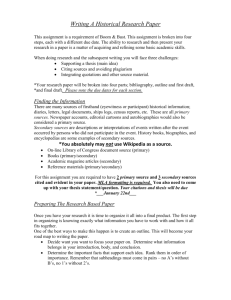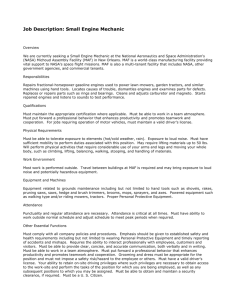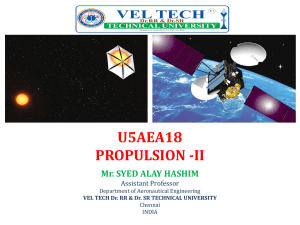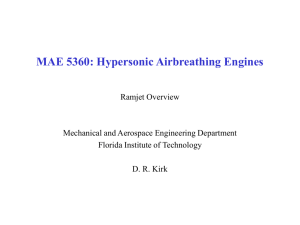Supersonic Flight - Workforce Solutions
advertisement
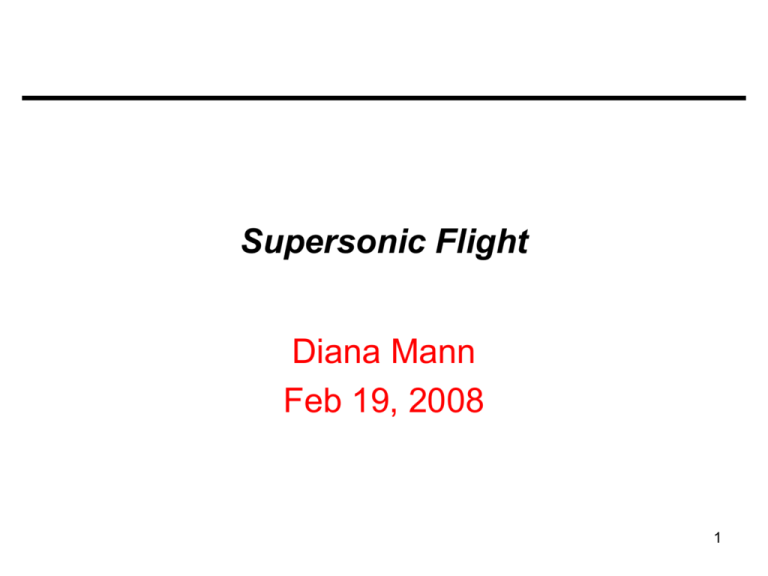
Supersonic Flight Diana Mann Feb 19, 2008 1 Agenda • • • • • • • Review Of Speed Regimes Problems At High Speeds Supersonic Engines Special Materials Aerodynamics Special Shapes Bonus Section – Hypersonic X-Plane 2 Review of Speed Regimes (1 of 4) Velocity, Force, and Temperature Increase 3 Graphic courtesy of NASA Glenn Research Center Review of Speed Regimes (2 of 4) Low Subsonic V < 250 mph High Subsonic V < 600 mph General Aviation – Commuter Airliners Propeller Propulsion Aluminum Skin Straight Wings Turbofan Engines Aluminum Skin Swept Wings Graphics courtesy of NASA Glenn Research Center 4 Review of Speed Regimes (3 of 4) Low Supersonic V < 1500 mph High Supersonic V < 2500 mph Fighter Planes Spy Planes Afterburner Engines Aluminum Skin Swept Wings Ramjet Engines Titanium Skin Small Wings Graphics courtesy of NASA Glenn Research Center 5 Review of Speed Regimes (4 of 4) Low Hypersonic V < 6000 mph High Hypersonic V < 17,500 mph X - Planes Space Shuttle Scramjet or Rocket Engine Cooled Titanium – Nickel Skin Short Wings Rocket Engines Thermal Protection System Short Blunt Wings Graphics courtesy of NASA Glenn Research Center 6 Operational Envelopes 7 http://www.aircraftenginedesign.com/custom.html4.html Problems at High Speeds • Large Forces – Forces increase as the square of velocity • Need Bigger Engines • Need Stronger Airframe • Need Special Shapes • High Temperatures – Friction heating increases with velocity • Need Special Materials • Need Active Cooling 8 Slide courtesy of NASA Glenn Research Center Supersonic Engines • Propeller Propulsion • Turbofan Engines • Ramjet Engines As engines become more powerful, Thrust Increases • Scramjet Engines • Rocket Engines 9 General Thrust Equation 10 Graphic courtesy of NASA Glenn Research Center Excess Thrust (Thrust – Drag) 11 Graphic courtesy of NASA Glenn Research Center Ramjet Engines • No moving parts • Speed of the jet "rams" or forces air into the engine • The ramjet develops no static thrust and very little thrust in general below the speed of sound • Ramjet vehicles require some form of assisted takeoff, such as another aircraft or booster 12 http://www.ueet.nasa.gov/Engines101.html#types Scramjet Engines • Ramjets with supersonic combustion are known as SCRAMJET (supersonic combustion ramjet) engines – Air-breathing engine in which the airflow through the engine remains supersonic • Another engine system is required to accelerate the aircraft to ramjet velocities 13 http://en.wikipedia.org/wiki/Scramjet Rocket Engines • Rocket engines are reaction engines – The basic principle driving a rocket engine is Newton’s 3rd Law: • “To every action there is an equal and opposite reaction" – A rocket engine ejects mass in one direction and benefits from the reaction that occurs in the other direction as a result http://science.howstuffworks.com/rocket.htm 14 Special Materials • Address larger forces and increased temperature at high velocity – Aluminum Skin – Titanium Skin – Cooled Titanium / Nickel Skin – Thermal Protection System (TPS) • Melting Points – Al: 220 °F (660 °C) – Ti: 3263 °F (1795 °C) – TPS (Silicon): 2588 °F (1420 °C) 15 Space Shuttle Thermal Protection System – Ceramic Tiles 16 http://en.wikipedia.org/wiki/Space_Shuttle_thermal_protection_system Aerodynamics • A branch of dynamics concerned with studying the motion of air, particularly when it interacts with a moving object Designers match airframe and propulsion system capabilities 17 http://en.wikipedia.org/wiki/Aerodynamics Aerodynamics Is Really Fluid Dynamics • When an object passes through the air, it creates a series of pressure waves – These waves travel at the speed of sound • As aircraft speed increases, the waves compress and merge into a single shock wave moving at the speed of sound – Speed of Sound 761 mph (~1,225 kph) at sea level – A.k.a. Mach 1 18 http://en.wikipedia.org/wiki/Sonic_boom Speed of Sound 19 Graphic courtesy of NASA Glenn Research Center Laminar Flow • Laminar flow occurs when a fluid flows in parallel layers, with no disruption between the layers • It is the opposite of turbulent • In nonscientific terms laminar flow is "smooth," while turbulent flow is "rough" Graphic courtesy of NASA Glenn Research Center Text courtesy of http://en.wikipedia.org/wiki/Laminar_flow 20 Shock Waves (1 of 3) • The speed at which some portion of the airflow over the wing first equals Mach 1.0 is termed the Critical Mach Number – This is also the speed at which a shock wave first appears on the airplane • A shock wave is formed where the airflow suddenly returns to subsonic flow • Shock wave becomes more severe and moves aft on the wing as speed of the wing is increased • Eventually flow separation occurs behind the welldeveloped shock wave Cross Section of a wing http://en.wikipedia.org/wiki/Shock_wave 21 Shock Waves (2 of 3) 22 Shock Waves (3 of 3) 23 Normal Shock Waves 24 Graphic courtesy of NASA Glenn Research Center Oblique Shock Waves 25 Graphic courtesy of NASA Glenn Research Center Crossed Shock Waves 26 Graphic courtesy of NASA Glenn Research Center Shock Wave Imaged at Mach 7 27 Schlieren Photography • Schlieren photography is a visual process used to photograph the flow of fluids of varying densities – Used to visualize airflow over an aircraft traveling at supersonic speeds – Maps the variations of density in fluids • Since shock waves are regions of higher pressure than normal air pressure, their density is greater than that of normal air pressure • Pressure differential created by the shock waves allows the shape of the shock waves to be imaged – Invented by the German physicist August Toepler in 1864 to study supersonic motion • Its role is changing due to the increasing use of computational fluid dynamics, where the same principle is used to display the computed results as flow images 28 Computational Fluid Dynamics • • Computational fluid dynamics (CFD) is one of the branches of fluid mechanics that uses numerical methods and algorithms to solve and analyze problems involving fluid flow During preprocessing – – The geometry (physical bounds) of the problem is defined The volume occupied by the fluid is divided into discrete cells (the mesh) • – The physical model is defined • – • • equations of motions + enthalpy + radiation + species conservation Boundary conditions are defined • • The mesh may be uniform or non uniform Specifies fluid behavior and properties at the boundaries of the problem For transient problems, the initial conditions are also defined The simulation is started and the equations are solved iteratively as a steady-state or transient Finally a postprocessor is used for the analysis and visualization of the resulting solution A computer simulation of high velocity air flow around the Space Shuttle during re-entry. http://en.wikipedia.org/wiki/Computational_fluid_dynamics 29 Vapor Cones • The condensation “cloud” marks the approximate location of the shock wave • It’s called the Prandtl-Glauert singularity – The point at which a sudden drop in air pressure occur – Generally accepted as the cause of the visible condensation cloud that often surrounds an aircraft traveling at transonic speeds http://en.wikipedia.org/wiki/Prandtl-Glauert_singularity http://en.wikipedia.org/wiki/Image:FA-18_Hornet_breaking_sound_barrier_%287_July_1999%29.jpg 30 Special Shapes (1 of 2) 31 http://airwarrior.afkamm.co.uk/Aerodynamics/aero5.shtml Special Shapes (2 of 2) • NASA believes that aircraft of the future can mimic the flight of birds, flying more efficiently and safely • This video shows what NASA has observed in the flight of an eagle that can be translated into a concept for a future aircraft • For example, just as a bird uses different feathers on its wings to control flight, aircraft wing shapes can be designed to change and adapt to constantly changing conditions of flight • Or, an aircraft can mimic the way a bird lands, greatly decreasing the amount of fuel and runway space required 32 http://www.hq.nasa.gov/office/aero/videos/eagle_morph.htm Bonus Section – Hypersonic X-Plane (1 of 4) • The X-43A was a small experimental research aircraft designed to flightdemonstrate the technology of airframe-integrated scramjet propulsion at hypersonic speeds above Mach 5 33 http://www.nasa.gov/centers/dryden/history/pastprojects/HyperX/index.html Bonus Section – Hypersonic X-Plane (2 of 4) • On June 2, 2001, the X-43A "stack" -- a modified Orbital Sciences Corporation’s Pegasus XL booster topped with the Hyper-X research vehicle -- was released from a B-52 carrier aircraft • Booster ignition went as planned, with the aircraft accelerating on its predetermined high-altitude ascent • Seconds later, however, booster fins broke off and the aircraft spun out of control • The vehicle was then destroyed by range control 34 http://www.space.com/businesstechnology/technology/x43a_report_030718.html Bonus Section – Hypersonic X-Plane (3 of 4) • NASA convened the X-43A Mishap Investigation Board (MIB) to look into the failure on June 5, 2001 at NASA’s Dryden Flight Research Center at Edwards, CA – Because of the increased thermal loads predicted for the flight trajectory, changes were made in thermal protection to the Hyper-X launch vehicle wing, fins and body • Additional thermal protection was not taken into account in preflight wind tunnel test modeling • Computer and wind tunnel tests to help understand what caused the failure showed the new thermal protection altered the booster’s aerodynamic characteristics 35 http://www.space.com/businesstechnology/technology/x43a_report_030718.html Bonus Section – Hypersonic X-Plane (4 of 4) • Enter the X-51 – The Air Force Research Laboratory’s X-51 ScramjetWaverider is being built by Pratt & Whitney and Boeing – This scramjet demonstrator is to fly by 2009 at target speeds close to Mach 7 (around 8,050 km/h) • Ground tests of the X-51A began in late 2006 – For the flight demonstrations, a B52 will carry the vehicle to an altitude of about 35,000 feet and then release it. – Initially propelled by an Army Tactical Missile System (ATACMS) solid rocket booster, the scramjet will take over at approximately Mach 4.5, and the vehicle will accelerate to a flight speed near Mach 7 412th TW tests X-51 antennas An X-51 Scramjet-Waverider mock-up hangs inside the Benefield Anechoic Facility here during the vehicle's antenna testing. The 412th Test Wing Hypersonic Flight Test Team, Electronic Warfare and Boeing began the month-long testing Jan. 28. (Air Force photo by Mike Cassidy) 36 http://www.edwards.af.mil/news/story.asp?id=123084673 Selected Links • • • • http://www.ueet.nasa.gov/Engines101.html http://wings.avkids.com/Book/advanced.html http://travel.howstuffworks.com/turbine6.htm http://www.aircraftenginedesign.com/custom.htm l4.html • http://en.wikipedia.org/wiki/Aerodynamics#Super sonic_aerodynamics • http://www.wilk4.com/misc/soundbreak.htm 37 EngineSim Exercises 38 EngineSim Exercises (1 of 4) • Set the following conditions in EngineSim: – – – – – • Design Mode English Units Turbojet Output: Graphs Input Speed + Altitude Set the Airspeed to 0 mph, the Altitude 0 ft, and the Throttle 100. – Record Net Thrust ___________ – Record Fuel Flow ____________ • • What happens when you choose a different engine? – Choose a jet with afterburner • Record Net Thrust ___________ • Record Fuel Flow ____________ – Choose a turbofan engine • Record Net Thrust ___________ • Record Fuel Flow ____________ – Choose a ramjet engine • Record Net Thrust ___________ • Record Fuel Flow ____________ Now change the Airspeed to 350, and the Altitude to 10,000 ft. – Record Net Thrust ___________ – Record Fuel Flow ____________ 39 EngineSim Exercises (2 of 4) • What can you conclude about the effect of an increase in altitude and airspeed on thrust? __________________________________ • On fuel flow?_______________________ • Which engine is most fuel efficient? _______________________________ 40 EngineSim Exercises (3 of 4) • What happens when you increase speed? – Select Turbojet, and set Airspeed to 1500 mph (Low Supersonic) • Record Net Thrust ________ • Record Fuel Flow _________ – Select Afterburner, and set Airspeed to 1500 mph (Low Supersonic) • Record Net Thrust ________ • Record Fuel Flow _________ – Select Turbofan, and Set Airspeed to 1500 mph (Low Supersonic) • Record Net Thrust ________ • Record Fuel Flow _________ – Select Ramjet, and Set Airspeed to 1500 mph (Low Supersonic) • Record Net Thrust ________ • Record Fuel Flow _________ 41 EngineSim Exercises (4 of 4) • Examine the graph on the right. Where is the pressure greatest for each engine? _________________________________ • Bonus Question: – How are pressure and temperature related?____________________________ 42 This workforce solution was funded by a grant awarded under the Workforce Innovation in Regional Development (WIRED) as implemented by the U.S. Department of Labor’s Employment and Training Administration working in partnership with the Colorado Department of Labor and Employment, the Metro Denver Economic Development Corporation, and the City and County of Denver's Office of Economic Development. The solution was created by the grantee and does not necessarily reflect the official position of the U.S. Department of Labor. The Department of Labor makes no guarantees, warranties, or assurances of any kind, express or implied, with respect to such information, including any information on linked sites and including, but not limited to, accuracy of the information or its completeness, timeliness, usefulness, adequacy, continued availability, or ownership. This solution is copyrighted by the institution that created it. Internal use by an organization and/or personal use by an individual for non-commercial purposes is permissible. All other uses require the prior authorization of the copyright owner. 43


